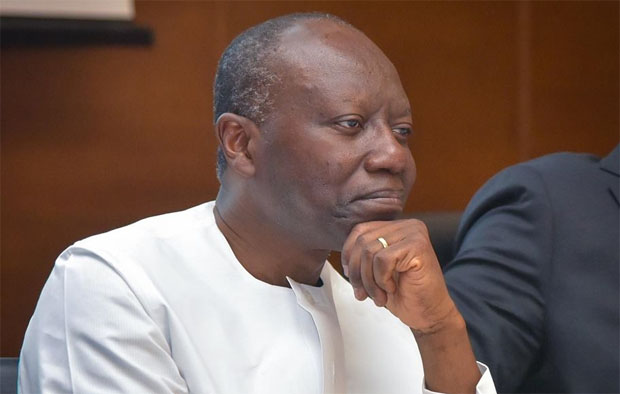Dr. Gideon Boako[/caption] The Ato Forson led Caucus Group (hereinafter referred to as AFLC Group), during its press conference on Wednesday, 20th March, 2019 asked 5 questions for the Vice President, Dr. Mahamudu Bawumia to answer. Reading the questions, one wonders if Ato-Forson and his cohorts are deemed to sit some undergraduate final year macroeconomics exams (ECON 404) and they need answers to some possible questions they have dreamt about. I am not going to speak broadly to the entire contents of the presser but rather deal specifically with the ‘so called’ five questions they posed to the erudite economist, Dr. Mahamudu Bawumia. First and foremost, does the Ato-Forson group really understand the questions they asked? I ask this because whoever wants a question answered on a particular subject must come with some minimum knowledge and understanding of the subject. Just the sheer misplacement or misdirection of the questions suggest a student who doesn’t actually have the basics of the subject matter on which he/she is asking the question. What AFLC group did is akin to a student who just goes to the internet to extract any questions and takes to class to ask a tutor. Because he does not understand the subject around which the questions are formed he ends up taking it to the wrong tutor. This is what they have done. In the spirit of such lack of understanding on the part of the AFLC, it is important the Vice President does not waste his precious energies and time answering them. I will handle them in my own capacity. Interestingly, the first four questions asked the Vice President to explain why an “independent central bank” like the Bank of Ghana (BoG) would take particular decisions. The answer to these first four questions is very simple. All the four questions are incompetent! They demonstrate a complete lack of understanding by Ato-Forson of how an independent central bank works. Why is that so? This is because Section 3 of the Bank of Ghana Act, 2002 (Act 612) states as follows: “3. (I) The primary objective of the Bank is to maintain stability in the general level of prices. (2) Without prejudice to subsection (1) the Bank shall support the general economic policy of the Government and promote economic growth and effective and efficient operation of banking and credit systems in the country, independent of instructions from the Government or any other authority”. What Section 3 of the Act simply states is that the central bank makes its decisions independent of instructions from Government or any other authority, so why would the AFLC group expect the Vice President to tell them the reasons why an independent central bank took a particular decision? Do they understand what “independent” means? If they want to find out why the central bank took a particular decision they should ask the central bank. These questions clearly demonstrate the AFLC group’s gross incompetence! Having said this, I will, for the purposes of helping Ato-Forson and his group to prepare for their ECON 404 exams give question by question responses to all the questions they asked so they don’t come back again, knowing my answers are their surest ways of preparing for the exams. It is called helping the needy, isn’t it? Hahahaha. Since I am not a member of the Monetary Policy Committee (MPC) of any central bank or the BoG, my answers can only be based on my own intuition and what economic thoughts and theories postulate. Q1: In the first question, the ATO FORSON LED CAUCUS Group (AFLC Group) asked why an independent central bank with focus on price stability decide to reduce the monetary policy rate against its own research findings that US policy normalization is strengthening the US dollar and causing investors to move funds away from emerging economies and that upward adjustments in domestic prices of petroleum products are likely to affect transport and utility prices? Response: Here, I presume they understand what policy rate normalization is. I think if Ato-Forson and his cohorts had invested a little bit of time to read they would have fully appreciated the import of the Bank of Ghana’s MPC Press Statement of January 28, 2019. In the statement (herewith paraphrased), the central bank reports that the decision to lower the policy rate was influenced by external sector conditions—trade tensions and potential for further tightening of interest rates abroad—, which was heightened at the November MPC meeting and which had dissipated at the January 2019 meeting. For this reason, with the potential for economic disruption from a potential trade war and further tightening of interest rates by the FED, now eliminated from the risk equation and the fact that inflation was expected to remain well-contained over the forecast horizon ( refer to ¶5 of the press statement), supported by a relatively tight monetary policy stance, the immediate risks to the disinflation path are well contained, and the current state of the macroeconomic fundamentals provided some scope to translate some of the gains in the macro stability to the economy. The translation of the gains to the economy is expected to help support activity in the non-oil sector of the economy. Under the circumstances, the Committee voted unanimously to lower its policy rate to 16 percent. I believe the second leg of the question referred to an own in-house research finding of the Central Bank which suggested that US policy normalization is strengthening the US dollar and causing investors to move funds away from emerging economies and that upward adjustments in domestic prices of petroleum products are likely to affect transport and utility prices. In fact, if the AFLC Group did again take time to read that research paper, which was extensive in its work and findings they would have realized that a key conclusion of that work was that upon impact of external sector shocks, the state of the domestic macroeconomic conditions was key in limiting the transmission of the external sector shocks on the domestic economy. And so if crude oil prices go up and domestic prices of petroleum products adjust upwards accordingly, the extent to which domestic inflation will respond will be determined by a whole host of factors including the fundamentals and degree to which businesses would be prepared to pass on these price increases to consumers. This is what is known as the transmission effect dynamics and it would have been nice if this AFLC had invested a little bit of time to properly educate its audience. Q2: Let me turn to the second question. The AFLC group asked why an independent central bank, with focus on price stability, decided to lower the policy rate in the face of dwindling net international reserves and a rising interest rate abroad? Response: To begin with, the premise of this question is false and fraught with inconsistencies. I am still wondering whether these AFLC guys do read and whether they are in tune with external sector developments. Because, the FED by the end of the year had signalled that they were moving to pause their interest rate hike policy on account of projections of a slowdown in the US economy. In fact, in March 2019, the FED signalled to hold off interest rate increases for 2019. Since MPC decisions of central banks, at all times, are based on a variety of indicators that are monitored economy-wide, the triggers of the rate cuts could be influenced by the FED signal and other factors. It is important one does not look at the issues simplistically, as I can see done by the AFLC group. I know their mind-set and they are thinking that by raising interest rates, it will allow for portfolio flows into the economy. They need to keep their eye on the big picture. Economic growth and jobs remain a concern and in my view, a lowering of the policy rate was an optimal decision if the private sector was the focus of the central bank. Q3: The third question by this AFLC group is on the inflation-growth nexus. The question was on why would an independent central bank with focus on price stability decide to reduce the monetary policy rate in favour of growth, which has been projected to be higher than the previous year’s, while the local currency is under pressure? Response: I think that the answer to this question is already provided for in my response to the second question. In the first place I don’t think that it is a wrong policy choice for a central bank to lower the policy rate in favour of growth objectives. For so long as inflation remains well contained, that policy choice will always be consistent. The fact that growth is being projected to grow slightly higher than the previous year’s growth rate provides no reasonable justification for the argument provided by the AFLC group. In fact, a decomposition of the growth numbers will show that the growth story is oil-driven. The non-oil growth story has also been weak and has remained sub-optimal since the era of energy supply shock which remain protracted all through 2014-15. Any well-meaning policy makers would, at all times, prefer to see a vibrant non-oil economic sectors that deliver on job creation. I have read the January 2019 MPC Press statement and in paragraph 7 (7), one can clearly see that the central bank’s data on the real sector of the economy, derived from movements in its composite index of economic activity (CIEA) reflected some weaknesses. On this basis, I am sure the MPC’s policy decision was within the context of balancing the risks to inflation and growth. Q4: The fourth question is asking why a central bank will decide to lower its policy rate in the face of excess liquidity in the banking sector emanating from banks increasing their minimum capital by over 100 percent, while the local currency is fast depreciating. Response: I find it a little bit difficult to understand why the AFLC group is linking excess liquidity to the increased minimum capital requirement of banks. I can see a simple lack of understanding on this matter by the AFLC group. They must disabuse their minds of the erroneous fact that capitalization exercises by central banks invariably results in excess liquidity in the banking system which requires a higher interest rate response to help in mopping up efforts. In any case, is there excess liquidity in the economy? The answer is NO. Excess liquidity conditions are normally reflected in high currency outside banks which manifests itself in high growth in the key monetary aggregate of money supply. In 2018, money supply actually declined, and the trend has continued in 2019 so far. Even if it were the case that excess liquidity existed in the economy, the Central Bank, in my mind, would deploy the tools available at its disposal to effectively embark on a sterilization operation to help siphon the excess liquidly which could be potentially inflationary. Liquidity on the contrary remains tight. The recapitalization exercise on the contrary has been successful. New capital as a result has been injected into the economy through the banks. Weaker and undercapitalised banks that posed risks to financial stability have been removed. The injected capital- from domestic and external sources- will enhance the efficiency and profitability of the remaining banks, restore confidence and enhance the resilience of the banking sector. In the end, banks will be expected to be better positioned to support private sector-led growth which is the desired path that we all seek. Q5: The fifth question asks why a rapid exchange rate depreciation can be accompanied by single digit inflation. Response: This is quite elementary. But let me highlight on the economics of exchange rate. In fact, the question by the AFLC group on the apparent divergence between exchange rate depreciation and inflation further confirms how strong the macro fundamentals are now. As macroeconomic fundamentals strengthen and become well anchored, the pass-through from exchange rate depreciation, which are clearly not driven by the fundamentals, to inflation gets muted. This clearly is the difference between the NPP government’s handling of the economy and what we experienced under NDC where inflation shot up significantly in line with the sustained episode of exchange rate depreciation. The difference between the two is very clear and the credibility of current policies has helped to drive the correction in the exchange rate we have seen in the last week. And so yes, you can have high exchange rate depreciation with low inflation when first, the cause of depreciation is not reflective of the fundamentals, and second, policy credibility is strong. I will end the response to the questions here but would want to offer a piece of advice to the AFLC group. As I will always maintain, they must invest some little time to read and shift the discourse on economic issues away from MEDIOCRITY into more serious POLICY ISSUES. I wish the AFLC Class and their Class Captain, Casiel Ato-Forson, all the best in the impending exams. Dr. Gideon Boako (Ph.D.)]]>
Recent Posts
- Seidu Agongo launches month-long Ramadan donations to mothers
- IWD: You are powerful, capable – Konadu Agyeman-Rawlings celebrates women
- Anas thanks Emir of Gombe for naming a Centre at North Eastern University after him
- Anas Aremeyaw Anas Multimedia Centre Commissioned at North Eastern University, Gombe
- Amend Transition Act to reflect current governance structure – Benjamin Quashie
- Evidence abounds that lithovit is efficacious: A-G defends withdrawal of Opuni-Agongo case
- Full Text: Check Attorney-General’s justification for discontinuing high-profile cases
- OSP declares Ken Ofori-Atta wanted in multiple corruption cases
Popular Stories
-
IWD: You are powerful, capable – Konadu Agyeman-Rawlings celebrates women
-
Seidu Agongo launches month-long Ramadan donations to mothers
-
Anas thanks Emir of Gombe for naming a Centre at North Eastern University after him
-
Anas Aremeyaw Anas Multimedia Centre Commissioned at North Eastern University, Gombe
-
Election 2024: Mahama names key public institutions to operate 24 hours
@2023 – Newstitbits.com. All Rights Reserved.


























